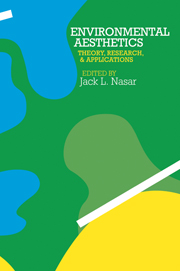Book contents
- Frontmatter
- Contents
- List of figures
- List of tables
- List of contributors and participants
- Acknowledgments
- Preface
- Section I Theory
- Section II Empirical studies
- Editor's introduction
- A Methodological comments
- B Architectural interiors
- Editor's introduction
- 11 The influence of a beautiful versus an ugly room on ratings of photographs of human faces: a replication of Maslow and Mintz
- 12 The development of a usable lexicon of environmental descriptors
- 13 Lighting-design decisions as interventions in human visual space
- C Architectural exteriors
- D Urban scenes
- E Natural and rural scenes
- Section III Applications
- References
- Index of authors
- Subject index
11 - The influence of a beautiful versus an ugly room on ratings of photographs of human faces: a replication of Maslow and Mintz
Published online by Cambridge University Press: 05 September 2013
- Frontmatter
- Contents
- List of figures
- List of tables
- List of contributors and participants
- Acknowledgments
- Preface
- Section I Theory
- Section II Empirical studies
- Editor's introduction
- A Methodological comments
- B Architectural interiors
- Editor's introduction
- 11 The influence of a beautiful versus an ugly room on ratings of photographs of human faces: a replication of Maslow and Mintz
- 12 The development of a usable lexicon of environmental descriptors
- 13 Lighting-design decisions as interventions in human visual space
- C Architectural exteriors
- D Urban scenes
- E Natural and rural scenes
- Section III Applications
- References
- Index of authors
- Subject index
Summary
Introduction
Although aesthetic concerns are central to many issues in architecture and environmental planning, there is little scientific evidence concerning the manner in which beautiful and ugly interior environments influence human behavior. Reviews of this work (Locasso, 1976) have indicated in general that few studies have been reported and that problems in experimental design, measurement, and methodology are common. There appears to be little solid empirical evidence demonstrating that attractive interior spaces exert some form of beneficial influence on human functioning and behavior.
Although not a cornerstone of the empirical literature, early work by Maslow and Mintz (1956) has received much exposure in environmental psychology and the environmental-design disciplines. They examined the effects of “beautiful” and “ugly” rooms on subjects' judgments of the amount of “energy” and “well-being” reflected in photographs of human faces. One of three experimentation rooms was decorated as a comfortable study and contained a mahogany desk and chair combination, a rug, drapes, paintings, sculptures, and other items. People who saw this room described it as “attractive,” “pretty,” “comfortable,” and “pleasant” (Maslow and Mintz, 1956, p. 247). The “ugly” room was described as “horrible,” “disgusting,” “ugly,” and “repulsive.” It contained “battleship gray walls, an overhead bulb with a dirty, torn, ill-fitting lampshade, and ‘furnishings’ to give the impression of a janitor's storeroom in disheveled condition” (Maslow and Mintz, 1956, p. 248). Two Es alternated between the two rooms and showed Ss a series of ten negatives of photographs. Subjects made judgments concerning the amount of “energy/fatigue” and “well-being/displeasure” that they saw in the faces pictured in the photos.
- Type
- Chapter
- Information
- Environmental AestheticsTheory, Research, and Application, pp. 134 - 143Publisher: Cambridge University PressPrint publication year: 1988
- 1
- Cited by



